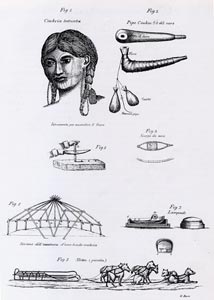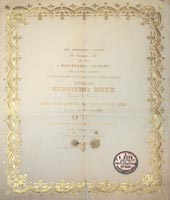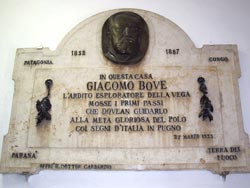|
The explorer Giacomo Bove was born in Maranzana (Piemonte), a little village in the Monferrato Hills, on the 23rd April 1852. His parents, Francesco Bove and Antonia Garbarino, were farmers and owned various vineyards.
In that period the Italian Territory was divided into small countries and governed by Austria, the Pope and the House of Savoy. But, little by little, there was an outbreak of wars, which would lead to independence and reunification.
Due to the Italian “Revival” the agriculture improved, thanks to the economical development achieved by Minister Camillo Benso, Count of Cavour. The Bove family produced and sold wine.
Giacomo was the eldest of five children: Giuseppe, Rosa, Isabella and Maria. After attending school in Acqui Terme and Maranzana, he seemed pleased to continue his studies. He went to boarding school in Genoa, birthplace of Mazzini. It was there that he saw the sea for the first time in his life and decided to join the Naval Academy, which he could attend, due to the proceeds of the family vineyards. After his graduation it was possible for him to become midshipman of the “Governolo”, a ship that was leaving for a scientific expedition in the Far East.
When he returned to Italy, he spent some time in Maranzana until he was called for duty in La Spezia and Naples. In February 1875 he asked to take part in the English expedition, led by Captain Nares, aboard the “Alert” and “Discovery”, to visit the Arctic polar region; nevertheless, the English government didn’t require officials from the Italian Navy.
In 1876 Giacomo asked to take part in the expedition of the state “Scioa”, in order to help the explorer, Antinori, in Ethiopia. Unfortunately, also this expedition refused his help. On the 24th September 1876 he was promoted to Second Lieutenant.
 In April 1877 he was invited aboard the “Washington” to study sea currents of the Messina Straits. He invented an instrument to study the currents and created records for that period. In April 1877 he was invited aboard the “Washington” to study sea currents of the Messina Straits. He invented an instrument to study the currents and created records for that period.
While he was in Messina he asked to take part in the expedition organized by the Scandinavian scientist and explorer, A.E. Nordenskiold, to discover the North-East passage, through the Artic Sea, from the Atlantic Ocean to the Pacific Ocean. Most probably, Giacomo was selected among a considerable number of Italians who had made the same request because of his speciality and studies of the currents. He would be the hydrographer of the expedition.
 At the end of the successful expedition (1878-1879) he came back to Maranzana to relax and be with his family. He then applied himself to the preparation of an exclusive Italian project concerning the Antarctic regions’ exploration.
At the end of the successful expedition (1878-1879) he came back to Maranzana to relax and be with his family. He then applied himself to the preparation of an exclusive Italian project concerning the Antarctic regions’ exploration.
The big project, accepted by everybody at first, was put aside due to the high costs in those very difficult times after the union of Italy.
However, it was accepted abroad; in fact, Argentina, considering his request for the Antarctic exploration, asking Giacomo to come to Buenos Aires to demonstrate his project and it supported the enterprise with a few modifications.
When he returned from his travels, he received from Christian IX, the King of Denmark, the honour of “Knight of Danebrog’s Order”. Also Maranzana honoured him with a gold medal and celebrated his promotion to Sub-Lieutenant, giving him a parchment of honour on the 20th June 1880.
On the 7th June 1881 he married Luisa Bruzzone, and on the 3rd September, he left for Argentina on the “Europa” ship.
The exploration lasted until the end of summer 1882 and terminated because of the “S. Jose” shipwreck.
On the 6th October 1882 a special evening was organized by the Government and the Argentine Geographic Society to celebrate Giacomo’s enterprise. The Minister of The Interior, on behalf of the President of the Argentine Republic, gave him a gold medal. Back in Italy, Giacomo proposed a new expedition to complete the studies initiated in the previous journey.
This time the Italian Geographic Society supported the enterprise and tried to involve the government. Also this time Argentina, by the Lloyd Argentinean of Buenos Aires, offered directly to Giacomo the possibility of using for the enterprise a steamship. Thanking them all, Giacomo left Genoa on the 3rd July 1883 on the steamship “Sud America”.
He returned to Italy in 1884 with 25 large cases full of anthropological, zoological, botanical collections.
He had also as a travelling companion Edmundo de Amicis. This exploration caused considerable interest all around the world but Giacomo considered it just another step in his aim to reach the Antarctica. This journey was covered by Bove in a book, “Notes about a Journey in “Missiones” and “high Paranŕ”.”
When Giacomo returned to Italy, he promoted again the idea of an Antarctic expedition. At that time in Europe the main interest was Africa and especially in the Congo region.
This was the main concern for possible exploration. England was preparing an expedition together with the Italian Ministry of Foreign Affairs. The Italians requested Giacomo as their representative for this journey.
They left on the 2nd December 1885 and returned to Italy on the 17th October 1886.
The African journey hit him badly, both in his physique and spirit. The continually high temperatures affected him badly and various cures were recommended.

 This, however, had no lasting affect and he resigned from the Navy. He then took over the “Veloce” of Genoa where he then resided.
This, however, had no lasting affect and he resigned from the Navy. He then took over the “Veloce” of Genoa where he then resided.
The illness gripped him to the extent that on a return from a trip to Austria he took his life on the 9th August 1887, in Verona.
His remains now rest in his family’s chapel in the cemetery of Maranzana.
|


 In April 1877 he was invited aboard the “Washington” to study sea currents of the Messina Straits. He invented an instrument to study the currents and created records for that period.
In April 1877 he was invited aboard the “Washington” to study sea currents of the Messina Straits. He invented an instrument to study the currents and created records for that period.

